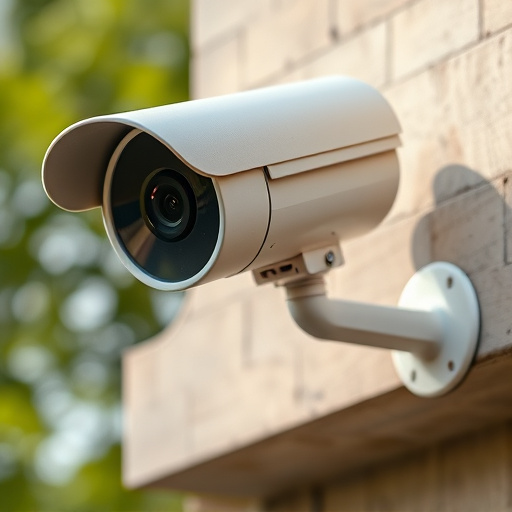Strategic mounting of realistic dummy cameras under eaves offers a discreet crime deterrent. Blending seamlessly into architecture, these cameras send a powerful signal to intruders while maintaining privacy and optimal monitoring visibility. Using advanced materials, they provide protection from vandalism and clear footage, enhancing overall security with responsible placement and regular maintenance.
Surveillance technology has evolved, introducing a subtle yet powerful tool: realistic-looking fake surveillance equipment. This article explores the world of dummy cameras, delving into their strategic design and placement for optimal discretion. We highlight the advantages of mounting these devices under eaves, enhancing security without compromising aesthetics. From materials and techniques to ensure realism to ethical considerations, this guide provides a comprehensive overview, including best practices for integrating dummy cameras into your security system while adhering to privacy standards.
- Understanding Dummy Cameras: Design and Placement
- Benefits of Mounting Under Eaves for Discretion
- Materials and Techniques for Realistic Appearance
- Ethical Considerations and Best Practices
Understanding Dummy Cameras: Design and Placement
Dummy cameras, also known as fake surveillance equipment, are becoming increasingly sophisticated in their design and functionality. When strategically placed, they can serve as effective deterrents against crime, providing a sense of security for homes and businesses. One common and discreet mounting method is to place dummy cameras under eaves. This tactic leverages the natural shadows and angles created by architectural features, making it harder for potential intruders to spot the difference between real and fake.
The design of these camera simulacras often includes intricate details such as LED lights that mimic the glow of actual sensors, adding to their realism. Placement under eaves or in other hard-to-see areas sends a powerful message to would-be criminals without compromising privacy. Proper positioning ensures that genuine surveillance cameras remain hidden while maintaining optimal visibility for monitoring purposes.
Benefits of Mounting Under Eaves for Discretion
Mounting dummy cameras under eaves offers a discreet and effective solution for surveillance needs. This strategic placement allows for unobtrusive observation, making it an ideal choice for those seeking to maintain privacy while gathering valuable security footage. By positioning fake surveillance equipment in this manner, homeowners and business owners alike can deter potential intruders without drawing unwanted attention.
The under-eave mounting method provides a number of advantages. It keeps the cameras out of sight, reducing the risk of vandalism or tampering. Additionally, this placement ensures that the cameras capture clear images, as the natural overhang offers protection from direct sunlight and weather conditions, enhancing the overall quality of the surveillance footage.
Materials and Techniques for Realistic Appearance
The key to achieving a realistic look for fake surveillance equipment lies in the materials and techniques employed. High-quality, lifelike props often utilize advanced technologies to mimic genuine cameras and sensors. Manufacturers use detailed 3D printing and molding processes to create housing that accurately replicates real camera bodies, complete with intricate details like lenses and mounting hardware. These physical features are then painted and weathered using specialized paints and effects to match various environments, from urban rooftops to rural landscapes.
One effective technique for making dummy cameras appear more convincing is the strategic Mounting Under Eaves. By attaching these fake surveillance devices discreetly beneath roof overhangs or in other shaded areas, they become virtually invisible to casual observation. This method not only enhances their realism but also leverages natural shadows to further blend them into the environment, making it far more difficult for potential intruders to detect them.
Ethical Considerations and Best Practices
When integrating realistic-looking fake surveillance equipment, such as dummy cameras, into your security system, it’s crucial to address ethical considerations and adhere to best practices. One key aspect is responsible placement, especially when using mounting dummy cameras under eaves. This strategy should be employed cautiously to avoid giving a false sense of complete security or invading privacy unnecessarily. It’s essential to respect the rights and expectations of neighbors and local communities, ensuring that the installation doesn’t create an atmosphere of mistrust or infringe upon any legal privacy protections.
Best practices suggest maintaining transparency about the surveillance setup, clearly communicating its purpose, and limiting its extent. Ethical use involves positioning dummy cameras in areas where they serve as a deterrent rather than intrusively monitoring private spaces. Regular maintenance and updates to these devices are also vital to prevent them from becoming outdated or attracting unwanted attention due to their presence.
Realistic looking fake surveillance equipment, or dummy cameras, offer a discrete and ethical solution for security needs. By understanding their design, placement strategies like mounting under eaves, and the materials used to achieve a lifelike appearance, you can effectively utilize this technology. Remember that while dummy cameras provide benefits for privacy and deterrence, ethical considerations should guide their use, ensuring they don’t create false security or invade genuine privacy. In terms of enhancing security discreetly, the strategic placement of mounting dummy cameras under eaves can be a game-changer.
